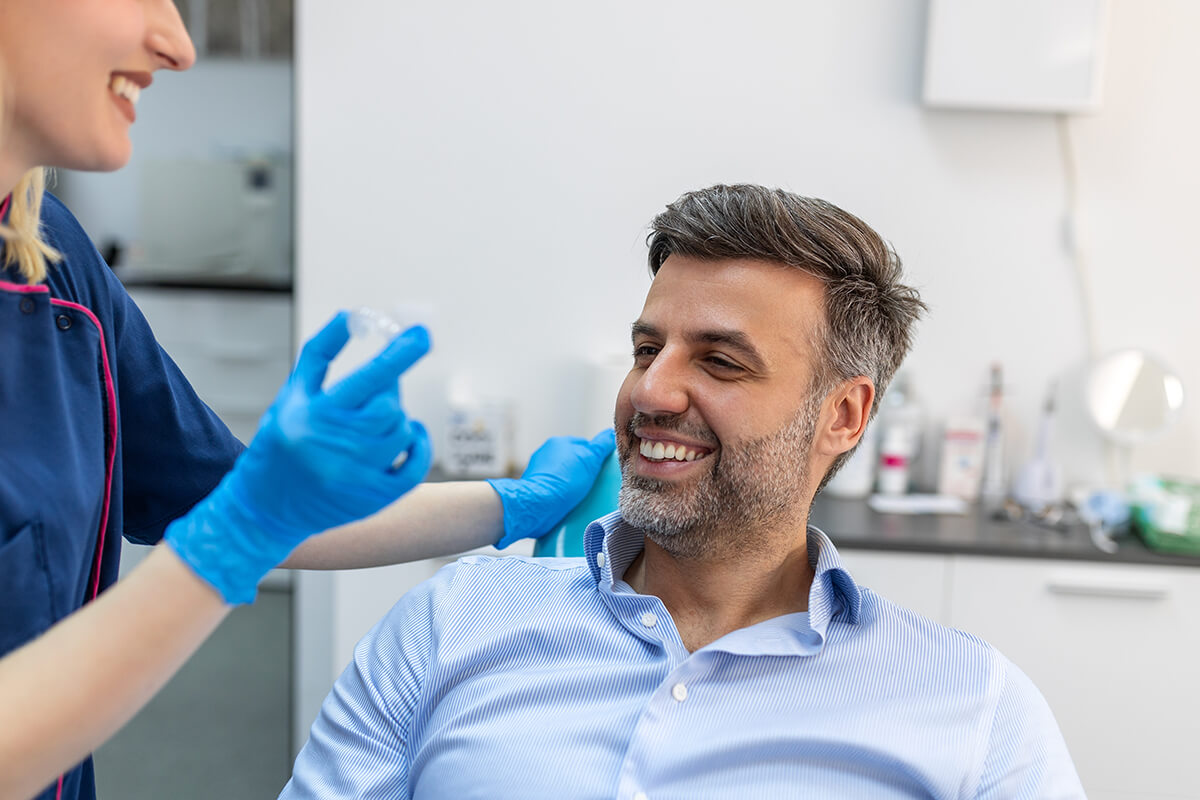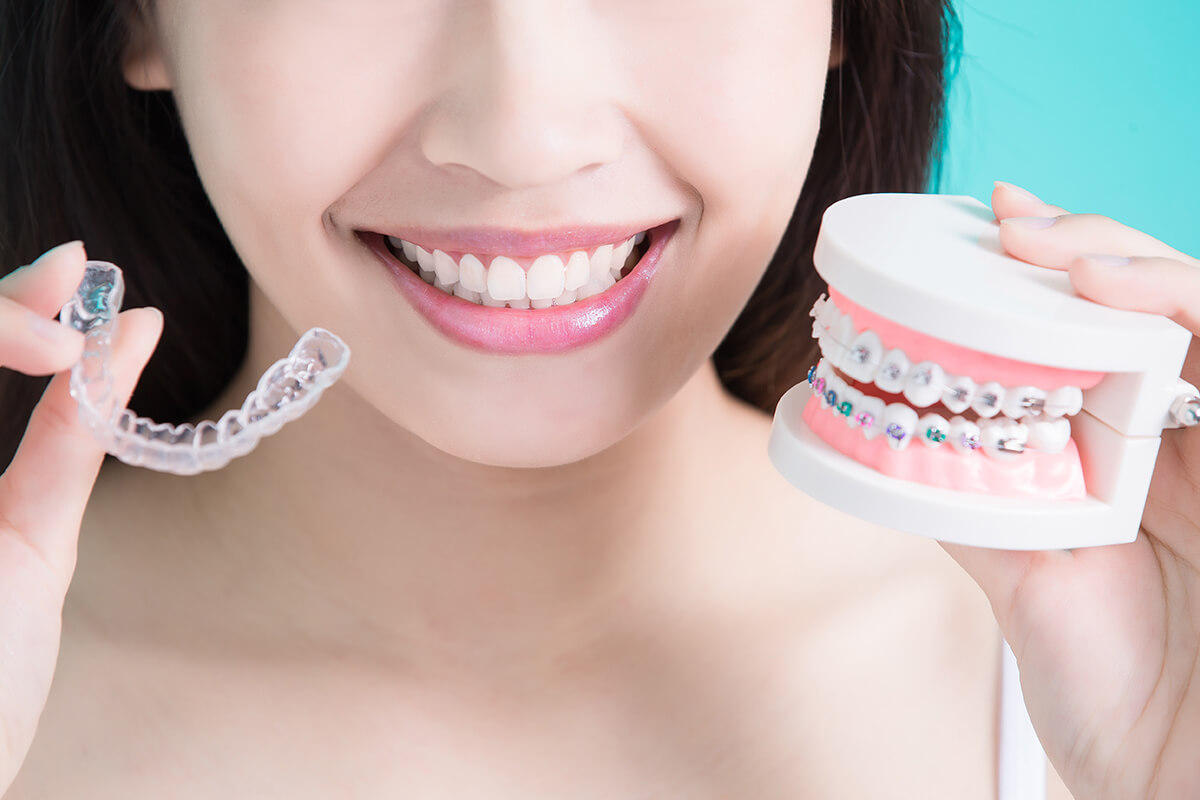Orthodontic treatments are becoming increasingly common for both teenagers and adults seeking to improve their smiles and oral health. Straighter teeth not only enhance aesthetics but also contribute to better functionality and overall well-being.
Two primary options dominate the field of teeth straightening: traditional braces and Invisalign. This article aims to guide you through the characteristics of each treatment, outlining their respective advantages and disadvantages to help you make an informed decision about which option best suits your individual needs and lifestyle.
What are Braces?
Traditional braces consist of metal brackets bonded to each tooth, connected by wires that exert pressure to gradually shift teeth into the desired position. The process begins with an initial consultation where the orthodontist assesses your oral health and takes impressions or digital scans of your teeth. Brackets are then affixed to the teeth, and the wires are adjusted periodically to guide tooth movement. Treatment duration varies depending on the complexity of the case.
While metal braces are the most common type, other options include ceramic braces, which are less noticeable due to their tooth-coloured appearance, and lingual braces, which are attached to the back of the teeth for enhanced discretion.
Pros and Cons of Braces
Pros:
- Versatility: Braces are highly versatile and can effectively address a wide spectrum of orthodontic issues, from minor crowding and spacing concerns to more complex bite problems and severe malocclusions.
- Cost-effectiveness: In general, traditional braces tend to be a more affordable and budget-friendly option for orthodontic treatment compared to Invisalign aligners.
- Durability: As braces are fixed to the teeth throughout the treatment duration, they offer enhanced durability and eliminate the risk of patients losing or misplacing their appliances.
- No compliance concerns: With braces, treatment progress is entirely dependent on the orthodontist’s adjustments, removing the responsibility of patient compliance with wearing aligners for a specified number of hours per day. This ensures consistent and predictable outcomes.
Cons:
- Appearance: Metal braces are the most visible type of orthodontic treatment, which can be a concern for image-conscious individuals.
- Discomfort: Brackets and wires can irritate the cheeks and gums, particularly during the initial adjustment period, and may require wax or other remedies for relief.
- Dietary restrictions: Certain foods, such as hard or sticky candies, popcorn, and chewy meats, must be avoided to prevent damage to the braces or wires.
- Oral hygiene challenges: Thorough brushing and flossing require more effort and specialized tools with braces to ensure effective plaque removal around the brackets and wires.
What is Invisalign?

Invisalign offers a modern approach to teeth straightening using a series of clear, removable aligners. These aligners are custom-made based on detailed 3D scans of the patient’s teeth.
The Invisalign process begins with a consultation similar to that for braces. If deemed suitable for Invisalign, the orthodontist takes digital scans of the patient’s teeth, which are used to create a treatment plan and fabricate the aligners. Patients wear each set of aligners for approximately two weeks before switching to the next set in the series, gradually moving their teeth into alignment.
The primary appeal of Invisalign lies in its discreet appearance, making it a popular choice for adults and self-conscious teenagers.
Pros and Cons of Invisalign
Pros:
- Aesthetics: Invisalign aligners offer a discreet aesthetic advantage, as they are virtually invisible when worn, unlike traditional braces.
- Removability: Invisalign’s removability allows for greater flexibility during meals, special occasions, and maintaining oral hygiene routines.
- Comfort: The smooth plastic aligners generally provide a more comfortable orthodontic experience, minimizing the irritation often associated with braces.
- Improved oral hygiene: The ability to remove Invisalign aligners makes it easier to maintain optimal oral hygiene through regular brushing and flossing.
Cons:
- Suitability limitations: Invisalign might not be suitable for complex cases involving severe bite issues or significant tooth rotations.
- Cost: Invisalign treatment generally involves a higher financial investment compared to traditional braces due to the technology involved.
- Compliance dependent: Treatment success with Invisalign relies heavily on patient responsibility, requiring consistent wear for 20-22 hours daily.
- Potential for loss or damage: The removable nature of Invisalign aligners increases the risk of misplacing or damaging them, potentially requiring replacements and added costs.
Factors to Consider

Choosing between braces and Invisalign is a personalized decision. Several factors warrant careful consideration to ensure the chosen treatment aligns with your specific needs and lifestyle:
- Complexity of orthodontic needs: Braces demonstrate versatility in addressing a variety of malocclusions, including severe crowding, rotations, and complex bite issues. Invisalign, while effective, is generally more suitable for mild to moderate orthodontic cases.
- Age: Both braces and Invisalign can effectively treat orthodontic issues across various age groups. However, Invisalign’s removability might pose challenges for younger children who may struggle with the responsibility of consistently wearing the aligners as prescribed.
- Lifestyle: Individuals who participate in contact sports or lead active lifestyles might find the fixed nature of braces a more secure and practical option. Invisalign’s removability caters well to those who prioritize aesthetics and convenient oral hygiene, particularly image-conscious adults and professionals.
- Budget: Traditional braces generally present a more budget-friendly solution for orthodontic treatment compared to Invisalign. It is essential to discuss payment plans and insurance coverage with your orthodontist to explore financing options that align with your financial situation.
- Oral hygiene habits: Both braces and Invisalign can be successfully managed with diligent oral hygiene practices. Invisalign’s removability simplifies brushing and flossing. However, individuals with braces must commit to meticulous cleaning around the brackets and wires to maintain optimal oral health.
- Compliance: Invisalign treatment demands consistent compliance with wearing the aligners for the recommended 20-22 hours per day throughout the entire treatment duration. Individuals who are confident in their ability to adhere to this requirement are well-suited for Invisalign.
- Aesthetics: For individuals who prioritize a discreet treatment option, Invisalign’s near invisibility offers a significant advantage over traditional braces. This is a particularly appealing factor for adults and self-conscious teenagers seeking to minimize the visual impact of orthodontic treatment.
The decision between braces and Invisalign is a significant one in your orthodontic journey. Both treatments offer effective solutions for achieving a straighter, healthier smile, each with its own set of advantages and limitations.
Carefully consider the factors discussed in this article, and schedule consultations with an orthodontist to discuss your individual needs and preferences. A thorough assessment of your orthodontic condition, combined with an understanding of your lifestyle and priorities, will guide you towards the most suitable treatment option.
To learn more about braces and Invisalign and determine which path is right for you, contact Kingsway Family Dentistry at (905) 563-4001. Our team is dedicated to providing personalized guidance and support throughout your orthodontic journey.

